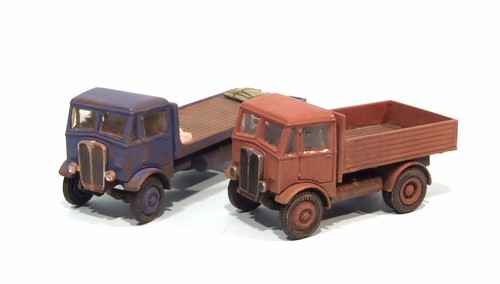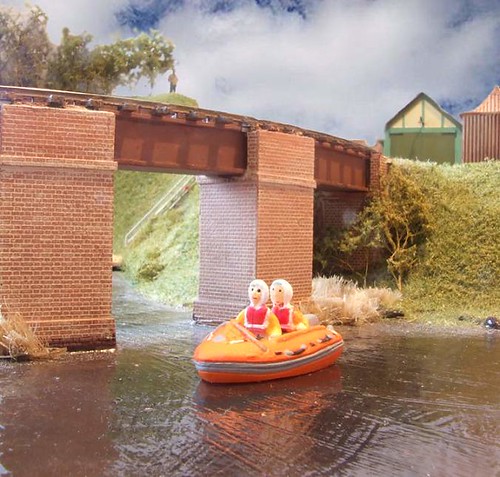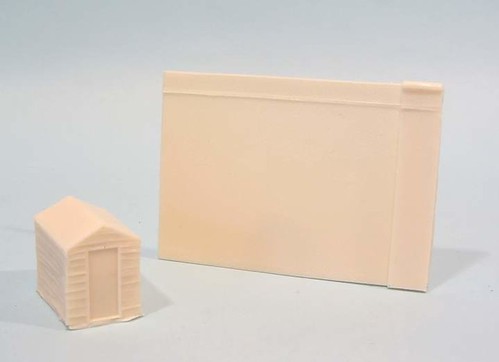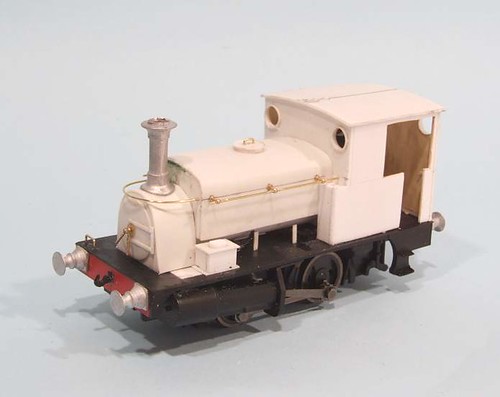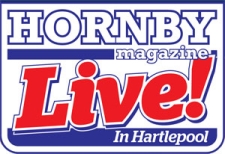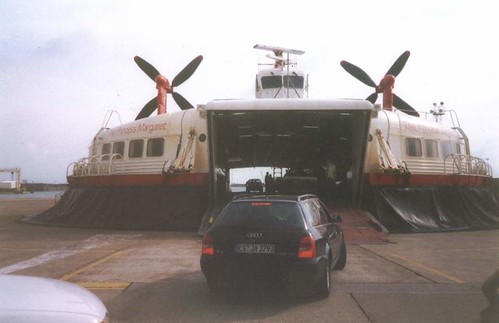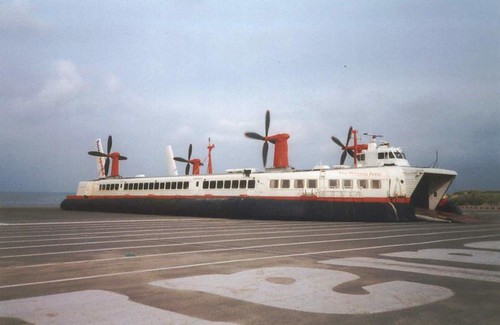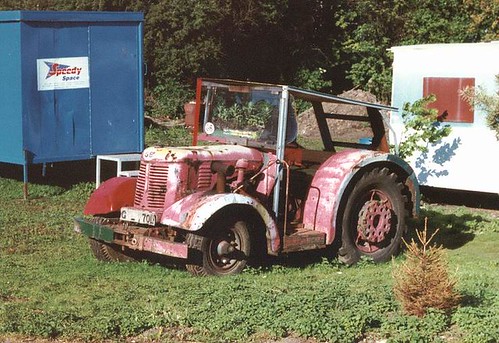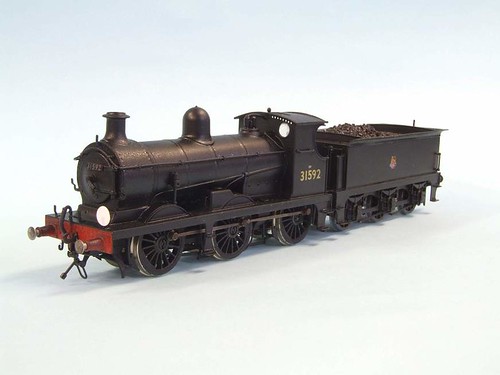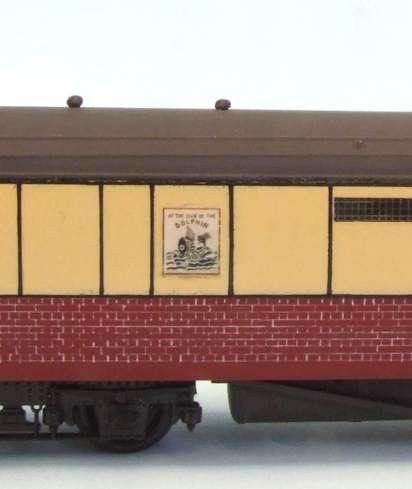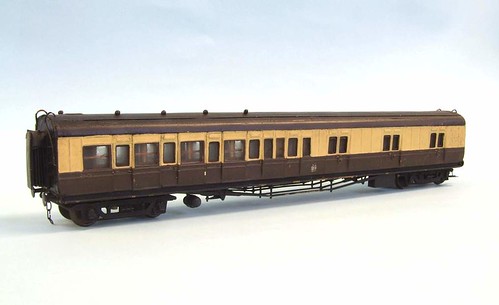A daily updated blog typed by someone with painty hands, oil under his fingernails and the smell of solder in his nostrils who likes making all sort of models and miniatures. And fixing things.
Tuesday, July 31, 2012
The road vehicles of Melbridge Dock - AEC Monarch
When I was building the Dock, most vehicle kits were whitemetal and rather cost more than I really wanted to spend on the meagre salary I earned. Luckily, the good people at Cooper Craft came to my rescue with their AEC Monarch plastic kit.
Available with several different flavours of tilt (the body behind the cab), in the good old days, pretty much every model railway layout had at least one of these somewhere. Hardly surprising as it's a good looking lorry with a nicely vintage appearance. More to the point the plastic kit was cheap and very nice to put together. It was easy to while away an evening building one and end up with a nice model for the train set for your efforts.
My examples are both liveried as transport for the owner of the stone warehouse at the left hand side as you look at the layout. "William Berry" is a fruit and wine importer, hence the barrels. Boxes and a canvas cover, well, they are everywhere aren't they ?
That cover denotes the lorry that sits under a hoist on the warehouse front. I'm assuming that once loaded, this will be spread over the back to keep everything in place and dry.
This kit is still available and still lovely to put together. If you've never built a plastic model before, go and have a go at one.
Monday, July 30, 2012
The road vehicles of Melbridge Dock - AEC Mammouths
Dave asks: I have always admired your layout reminds me of the Liverpool docks in some
ways. Can you tell me if you have time that is, what make of road vehicles you
have used.
As it happens Dave, now is just the time to explain. Lots of secret magazine work means less time for my own model-making fun. It's either explain the Dock road vehicles or you lot might not have anything to distract you from work or the Olympics...
OK, I have to start by explaining that Melbridge Dock is a very old model railway layout. It first burst on to the scene in 1988 and has attended exhibitions up and down the country ever since. We still love it and so do visitors to shows. Since it goes in the back of the car, exhibition managers please note, everyone wins.
As far as the vehicles go, the age means that most were built before the current availability of accurate die cast models. If I wanted to fill my roadways, it had to be done the hard way. Kits were built or bashed and what RTR there was got itself modified.
Which brings me to today's subjects - a pair of AEC Mammouth lorries that started life as die cast EFE 8-wheelers.
The more observant will have noticed that neither has 8 wheels, nor a long wheelbase. Those EFE's were fantastic models and appeared in bright, shiny form on every train set in the country. Obviously, I couldn't just take the tings out of the box and use them - no, I discovered that if you drilled out the rivets underneath, the lorry returned to a pile of components.
If the metal bits found their way into some paint stripper, then some very nice castings were revealed. To make an even bigger difference, a little work with the junior hacksaw reduced the body and chassis lengths. After this, a coat of primer and some paint and my lorries were - different.
So unusual was it to perform this surgery that one of my early articles in the late, lamented Modelling Railways Illustrated, covered the building for the shortie brown lorry shown here. I don't know if I influenced anyone to have a go but if I did, it didn't do anything for the value of unmolested models as it's still diddly-squat.
As it happens Dave, now is just the time to explain. Lots of secret magazine work means less time for my own model-making fun. It's either explain the Dock road vehicles or you lot might not have anything to distract you from work or the Olympics...
OK, I have to start by explaining that Melbridge Dock is a very old model railway layout. It first burst on to the scene in 1988 and has attended exhibitions up and down the country ever since. We still love it and so do visitors to shows. Since it goes in the back of the car, exhibition managers please note, everyone wins.
As far as the vehicles go, the age means that most were built before the current availability of accurate die cast models. If I wanted to fill my roadways, it had to be done the hard way. Kits were built or bashed and what RTR there was got itself modified.
Which brings me to today's subjects - a pair of AEC Mammouth lorries that started life as die cast EFE 8-wheelers.
The more observant will have noticed that neither has 8 wheels, nor a long wheelbase. Those EFE's were fantastic models and appeared in bright, shiny form on every train set in the country. Obviously, I couldn't just take the tings out of the box and use them - no, I discovered that if you drilled out the rivets underneath, the lorry returned to a pile of components.
If the metal bits found their way into some paint stripper, then some very nice castings were revealed. To make an even bigger difference, a little work with the junior hacksaw reduced the body and chassis lengths. After this, a coat of primer and some paint and my lorries were - different.
So unusual was it to perform this surgery that one of my early articles in the late, lamented Modelling Railways Illustrated, covered the building for the shortie brown lorry shown here. I don't know if I influenced anyone to have a go but if I did, it didn't do anything for the value of unmolested models as it's still diddly-squat.
Labels:
ask phil,
Melbridge Dock,
model railway,
Road vehicles
Sunday, July 29, 2012
Electric Railway Museum
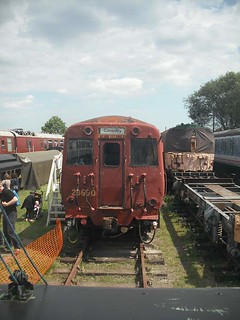 It's funny how you don't always visit attractions that are on your doorstep. I have been to Warwick Castle less than 5 times in my life and Shakespeare's birthplace a similar number, yet people trek around the world to have a poke around.
It's funny how you don't always visit attractions that are on your doorstep. I have been to Warwick Castle less than 5 times in my life and Shakespeare's birthplace a similar number, yet people trek around the world to have a poke around.Just over ten miles away is the Electric Railway Museum and generally I've never given it a second thought. OK, so when a friend mentioned the movement of an APT power car to the site a couple of years ago it crossed my mind that I ought to go and have a look. Before that I recall driving by and being surprised to see trains parked next to the airport.
But last week, there was a bit in the local rag mentioning an open weekend. This made me think I really ought to make the tiny effort required. After all, entrance was free and the weather fine. I'd run out of excuses.
Pulling into the parking field I was greeted with a trip back in time. This is how the major preservation societies looked many years ago. Very little in the way of permanent buildings, other than a signal box and station waiting shelter, and lots of unrestored rolling stock.
Lines of it in fact. Pretty impressive for a site with no rail connection.
From the name, you'll guess that the main subject for preservation is the electric train. Most of the exhibits are ex-BR electric sets that spent their lives in the south of England. Apart from the ones from the north that is.
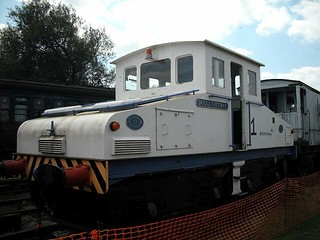 A couple of electric locos are also present. Two can run from banks of batteries in the noses fitted buy the original owners.
A couple of electric locos are also present. Two can run from banks of batteries in the noses fitted buy the original owners. With no 3rd rail or overhead, the most practical motive power are a couple of diesels, one of which I built of model of a few years ago. The 88DS operated a short test train consisting of a crane (the one Triang made), match wagon and brake van. It was nice to see something turn a wheel and I think the volunteers got as much out of it as we punters did.
My favorite loco of course, was the odd one. In this case, a Hibberd petrol powered loco with a chequered history. It seems the engine was constructed from Motor Rail bits at the Hibberd site, many of which date back to WW1. I'm certainly seeing a lot of narrow gauge loco in there but this is a standard gauge item, part of a class of 4 supplied to the Ministry of Agriculture, Fisheries and Food for shunting grain silos. It would make a fascinating model if I had the time...
In the middle of the site is a very good museum with displays explaining electric power and the trains that use it. Someone has out a lot of effort into this and it deserves wider exposure as it's really very good. There's also a cafe and gift shop selling "stuff" including old railway magazines, both old and very old. The later will be well worth a proper look next time I visit.
That next trip might be interesting though as the museum may be on the move. Not far, just down the road with a bit of luck. It seems some developers have got the OK to build on the site but Coventry City Council have said that the railway must be re-housed before this can happen. Luckily, there are possibilities that the volunteers seem very happy with and one option that could be helpful to the nearby village too, so maybe, everyone can win this time.
In the meantime, if you like electric trains, then this is well worth a look.
Electric Railway Museum Website
My photos on Flickr.
Saturday, July 28, 2012
Leftovers
I've been building a lot of kits recently and this has left me with the dilemma.
What to do with the leftovers ?
Schoolboy Phil used to be delighted when an Airfix kit had optional items. As well as finishing my aeroplane, I'd have some special bits to keep as well - a bonus !
Which is why I have boxes and drawers full of nicely moulded bits of plastic just waiting for a purpose. A purpose that will never arrive because I've forgotten that I own the things. Now the problem is getting worse as some of the bits leftover genuinely will be useful - I just need a filing system that lets me keep track of them.
Or I need to throw stuff away and forget it. Then I won't have a "Oh, I could have done with one of those moments" in a few weeks time.
Before I start filling the bin, does anyone have any sensible suggestions ?
Note: These are just the plastic bits. There are also some etched brass and whitemetal "goodies". And yes I know some of the stuff you see in the picture is useful and I will be filing the bigger sprues. And no, I will not post any bits out to you.
What to do with the leftovers ?
Schoolboy Phil used to be delighted when an Airfix kit had optional items. As well as finishing my aeroplane, I'd have some special bits to keep as well - a bonus !
Which is why I have boxes and drawers full of nicely moulded bits of plastic just waiting for a purpose. A purpose that will never arrive because I've forgotten that I own the things. Now the problem is getting worse as some of the bits leftover genuinely will be useful - I just need a filing system that lets me keep track of them.
Or I need to throw stuff away and forget it. Then I won't have a "Oh, I could have done with one of those moments" in a few weeks time.
Before I start filling the bin, does anyone have any sensible suggestions ?
Note: These are just the plastic bits. There are also some etched brass and whitemetal "goodies". And yes I know some of the stuff you see in the picture is useful and I will be filing the bigger sprues. And no, I will not post any bits out to you.
Friday, July 27, 2012
Austin 7
A few days ago, and Auston 7 Rally took place near where I live. Some of the owners didn't just travel over for the day, they decided to make a holiday of it. Since kipping in back of one of these cars isn't that practical, several chose to stay over at the holiday cottages next to our boat club.
Which is why I was able to take these photos as the vehicles lined up in the sun before setting out on a tour.
The great thing about classic car owners is that they love nothing more than talking about their car. If you happen to own an old banger (sorry, classic) yourself then they are extra interested and will talk about all sorts of anoraky technical details.
You also gain a level of trust that allows you to ask if you can sit in the car. Which is why I ended up folding myself into the driver seat of the second car on the right. It's owner did say that if I was driving I would need to put the seat right back and he wasn't kidding. Of course, doing this involved lifting the squab out and undoing bolts, so we didn't bother.
 What it did illustrate was just how small pre-war cars were. Our house was built in 1948 and houses my Beetle in the garage but will remove the wing mirrors from a modern car. We know this for a fact. Slide one of these babies in and you'll still be able to get out of the door. There will be plenty of space to work on the engine too and access through the bonnet is really excellent.
What it did illustrate was just how small pre-war cars were. Our house was built in 1948 and houses my Beetle in the garage but will remove the wing mirrors from a modern car. We know this for a fact. Slide one of these babies in and you'll still be able to get out of the door. There will be plenty of space to work on the engine too and access through the bonnet is really excellent.For a railway modeller, this sort of car will make your layout look OLD. The Austin 7 was produced until 1939 and would still have been a regular sight on the roads until 1960 when the MOT test would have dramatically reduced the number of rickety vehicles on the roads. Even then, cars weren't that common and owners were accustomed to mending their motors, hence the survival of them today.
Sadly, as far as I know (and please comment if I'm wrong), the RTR model world has neglected the Baby Austin. There are kits available from Scale Link in 4mm scale though and have one on Flockburgh from the 3mm Society. In 1/24th, South Eastern Finecast produce a very covetable kit and well as a couple of options for 7mm modellers.
Update: Another option is the Revell 3/15ps kit which is an Austin 7 variant built under licence. Left hand drive and 1:24 but worth a look if you can find one. Hat tip to Christopher Payne for this one.
Austin 7 Wikipedia Entry
Thursday, July 26, 2012
Busy Bodies figures
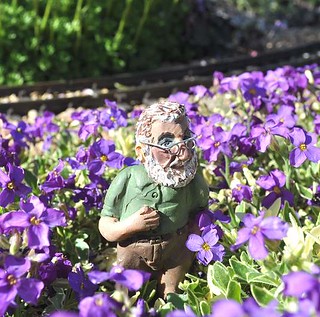 Matt asks:
Matt asks:
In the Hornby Magazine July Garden Rail Supplement, you briefly mentioned the Buzibodies range of figures. I cannot find anything about them on the net and wondered if you had any details of how someone would get hold of them ?
My mistake. The correct title is "Busy Bodies". They are produced by Rob Bennett and details can be found at:
Not the easist site to find via a search engine, although there are links from the 16mm and G Gauge societies website, but well worth a visit.
Wednesday, July 25, 2012
Book Review: Lost Railway Journeys by Paul Atterbury
As a railway modeller, I have to say this is a bad book. A very, very, bad book.
The problem is that I already have lots of models I would like to build. Up and down the country, there are lines that would, in my opinion, be fantastic to reproduce in miniature. Having read this book, there are several more to be added to this list. Unless I live to be 120, this isn't a good thing.
To be fair, for someone with an interest in railways, this is a sad book. Paul Atterbury describes 36 railway lines spread all over the country, including the Isle of Wight but not the Isle of Man, that have closed. Each one is is presented as a short description surrounded by photographs, advertising material and old memorabilia. The photos are especially good since most are of real places, not just engines in the countryside and ooze atmosphere.
The ages of the pictures vary. It's not all steam engines, there is a single car DMU in rail blue which manages to be just as nostalgic. Mind you, remembering how long it is since such a train ran in that colour on a real railway, perhaps this isn't a surprise. Quality wise, some of the early colour photos are lacking but I couldn't argue with their inclusion or for replacement with a sharper black and white shot.
Should you wish to follow in the authors footsteps, then he provides plenty of photos showing the remains of the lines. My favorite is Emneth Station where a new conservatory ends with a Mk1 coach. Much of the time there is very little to be seen but occasionally a little infrastructure remains or the trackbed is now a route for walkers, cyclists and horse riders. The final chapter provides anyone inspired with a few pointers on getting out and discovering more.
For the modeller then, this is a source of inspiration. Since most of the lines closed are branches, they are just the sort of thing that we are looking for. Some, such as the Lytnton & Barnstaple or Wantage Tramway, have been done many time before even if they still make an entertaining read. Others are less well covered. Killin Junction to Loch Tay is one I knew a little of but the photo showing a Caledonian tank hauling a single coach has so much atmosphere, I'd love to recreate it on Flockburgh. Aldeburgh station looks eminently modellable too.
I said this is a sad book and it is. As you read through it, just how much railway has been lost. The reasons are there too see - most of those trains are carrying tiny numbers of passengers - but if some of the lines had survived a few more years, how many would now see numbers boosted by tourism ?
Find out more about "Lost Railway Journeys" at Hobby Warehouse
The Hobby Warehouse
Tuesday, July 24, 2012
Deluxe Materials Solid Water
If you want to do a job properly, you have to collect the right tools. Deluxe Materials have a reputation for producing quality product and so I wasn't too unhappy at stumping up over a tenner for two small pots of resin that would produce, apparently, clear fake water.
In use, equal amounts of the two chemicals are mixed and the result poured into the place you want flooded.
As a test I decided to preserve my penultimate pot of genuine Humbrol Track colour paint. As you can see, the results are very effective with any air bubbles quickly leaving the "water" which is indeed, very clear.
The only problem is that after two days it hasn't set properly ! I assume I simply haven't measured and mixed properly. I did this by eye but next time will use the proper syringes. There should be plenty for the Canberra swimming pools and hopefully for some toy train projects I have ideas for.
Update: I've mixed and poured a second batch which has set perfectly overnight.
In use, equal amounts of the two chemicals are mixed and the result poured into the place you want flooded.
As a test I decided to preserve my penultimate pot of genuine Humbrol Track colour paint. As you can see, the results are very effective with any air bubbles quickly leaving the "water" which is indeed, very clear.
The only problem is that after two days it hasn't set properly ! I assume I simply haven't measured and mixed properly. I did this by eye but next time will use the proper syringes. There should be plenty for the Canberra swimming pools and hopefully for some toy train projects I have ideas for.
Update: I've mixed and poured a second batch which has set perfectly overnight.
Monday, July 23, 2012
GP Polyester Resin
Casting around for something to fill the swimming pools on the Canberra, I thought I had a suitable clear cast resin - Tiranti's "GP" Polyester Resin.
I thought I'd better experiment a little before working on the ship and I'm glad I did.
Once the correct catalyst had been found, I mixed up enough to fill a bottle cap. This was carried out in the garage because the stuff stinks. A lack of planning meant I didn't have anything to set in the resin but felt encasing something would be more interesting than just pouring it.
The only thing to hand was a dirty cotton bud from the spray booth. Needs must so I loped the end off and dropped it into the resin. Think bug encased in amber a la Jurassic Park.
Once set, I peeled the cap apart and you can see the result. It's clear-ish. Certainly no use for high class swimming pools. Maybe if it were a municipal baths full of mucky school kids...
I thought I'd better experiment a little before working on the ship and I'm glad I did.
Once the correct catalyst had been found, I mixed up enough to fill a bottle cap. This was carried out in the garage because the stuff stinks. A lack of planning meant I didn't have anything to set in the resin but felt encasing something would be more interesting than just pouring it.
The only thing to hand was a dirty cotton bud from the spray booth. Needs must so I loped the end off and dropped it into the resin. Think bug encased in amber a la Jurassic Park.
Once set, I peeled the cap apart and you can see the result. It's clear-ish. Certainly no use for high class swimming pools. Maybe if it were a municipal baths full of mucky school kids...
Sunday, July 22, 2012
SmallSpace Festival
 Over at the Scale Model News blog a few weeks ago, there was mention of an exhibition that sounded just up my street. The blurb promised "a galaxy of space, science-fiction and fantasy modelling." I wasn't busy and the venue was only an hour away, assuming I didn't get lost. And I could meet a hero - Matt Irvine.
Over at the Scale Model News blog a few weeks ago, there was mention of an exhibition that sounded just up my street. The blurb promised "a galaxy of space, science-fiction and fantasy modelling." I wasn't busy and the venue was only an hour away, assuming I didn't get lost. And I could meet a hero - Matt Irvine.Matt Irvine, for those who don't know, was the BBC special effects guru who not only built Blake's 7 but would turn up on Multi Colour Swapshop every Saturday morning to tell you how to do the same. I vividly remember him explaining how to make a teleport bracelet out of a slice from an orange juice bottle and a pink rubber. You don't get that in these CGI heavy days of modern telly.
Anyway, thanks to Mrs Satnav I found my way through the country lanes to the village hall where the show was being held. Although there was a car park advertised, this was full of Daleks so like everyone else, I parked on the verge some way down the road.
Wandering back to the hall, the first thing I saw was the costume from one of the Blake's 7 guards. As simple black suit with green visor and gas mask style thing, I always thought these were the best "baddie"costumes on television and to see one in the flesh was a real treat. OK, so there were stil daleks including some sort of emperor one but this was the business and I knew the trip had been worthwhile.
Having paid the pathetically low entrance fee of £2, I walked in to find Marvin, the paranoid android. The proper one from the telly series, not the film (apart from a walk on part in one scene) and it's fantastic.
The rest of the morning carried on in the same manner. On one table at the far side of the hall was a Space 1999 Eagle Transporter, the best space ship ever to appear in a sci fi show. Practical, rugged and with a certain beauty to us mechanical types, I don't think it has ever been bettered and best of all, no CGI, all the ships were models. At the show, I was looking at a restored original version a whopping 48 inches long. I suspect the organisers put it at the far end of the hall so I couldn't make a run with it. Mind you, if I was that way inclined then Marvin and the guard would have been coming with me !
On other tables Matt had brought the contents of his loft - better described as most of the telly shows I've enjoyed over the years. There was Liberator, Starbug (Red Dwarf), vehicles from Star Cops, a Tripod and even Orac.
Two "real" K9's were present as well as the man who provides the voice - something he does without electronic aids.
Elsewhere, Thunderbirds and Stingray replicas looked as good as the real things. Recreations of the puppets, including Lady Penelope and Parker, sat on a table near the door.
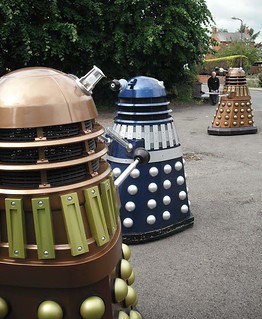 Should that not be enough, there was fantastic quality modelling both of odd-ball subjects and recreation of props. Even the trade, though limited, was excellent. I picked up several tools I'd never seen before and had I looked properly, would have walked away with an even bigger stash.
Should that not be enough, there was fantastic quality modelling both of odd-ball subjects and recreation of props. Even the trade, though limited, was excellent. I picked up several tools I'd never seen before and had I looked properly, would have walked away with an even bigger stash.All good things must come to an end but on leaving I could enjoy the sight of 3 full sized, radio control daleks in the car park and another K9. One of the daleks sprayed water from its gun and had "shot" a child who was suitably scared. I'm not sure that the dalek speaking to her was helping matters...
Look, it was brilliant, just go and have a gander at the photos.
Saturday, July 21, 2012
Missing "British"
I'm probably the last person to notice this, but has anyone looked at the "Cottages4You" TV advert and noticed that under the Haworth picture, the two model locomtives have been defaced ?
Each has had the word "British" from British Railways" removed.
Why ?
After all, if you want to remove the "branding", why not take it all off ? I'd have blanked the things entirely including the numbers. As it is, they just look odd.
Friday, July 20, 2012
Unusual transfers
Or: Don't posh people play a lot of tennis ?
The Canberra transfer (decal for American readers) sheet is covered with tennis courts and other oddball symbols (quoits ?). I've put 13 of them on the decks of the ship which has really filled those huge brown areas.
I'm used to numbers and names to be applied to a model but this is a first for me.
The quality of the transfer sheet is excellent. Perhaps this is a little more film around the edge of the lines than I would like but apart from that I have no complaints. The transfers were strong enough to be dragged around and released very quickly and easily from the sheets when soaked in cold water.
Lining things up against the raised plank edges isn't as easy as you might hope - the lines are feint and vanish under the film, but only a little prodding was required to line everything up.
Once blotted with a very soft tissue napkin that I can't remember the origin of but would like some more, Micro-Sol was sloshed everywhere to stick the things firmly in place.
Thursday, July 19, 2012
An unexpected appearance in Wikipedia for the Y6
If you keep loading photos onto the Interweb, it seems that people do stuff with them. Thus, I was very surprised to see on Nigel sending this message via the 3mm Society mailing list:
I see a pic of Phil Parker's Y6 is on Wikipedia, including a mention of 3mm. Well done, Phil.
What ?!
So, I nip over to the famous on-line encyclopedia and find the page looks like the photo above. You can see the real thing here.
The model is my attempt at an LNER Y6 painted in BR colours. Based on a Finney & Smith kit and powered by a BullAnt bogie, it was one of the fasted loco builds I've ever carried out. Looks nice too although I'd love to do an interior for it but the mechanical bits get in the way. Maybe when I unearth the 4mm version I have tucked away...
Anyway, you can read all about the build here.
Wednesday, July 18, 2012
Book review: Amazing & Extraordinary Facts, Trains & Railways
Did you know that to earn enough money for a single pencil, the Midland Railway had to haul a bag of maize for ten miles ? Or that to earn a fishplate took the haulage of a ton of salt for 16 miles ?
Nope, me neither.
And when I discovered that one of the least used stations in the UK can be found in Warwickshire, I couldn't resist immediately looking it up on my 'phone to see how easy it would be for me to visit.
Which is a good thing. A book like this should allow you to dip in and out as you feel like it. Think a buffet rather than full sit down meal and you get the idea.
Like a buffet, it shares the advantage that if you don't like something, you can ignore it. In my case this is the slimy stuff at a Chinese banquet or the reminiscences of author Julian Holland and his steam powered journeys as a young train spotter.
Being the third book in the series, it's preceded by Amazing & Extraordinary Railway Facts and More Amazing & Extraordinary Railway Facts, I wondered as I ploughed through the text, if the supply of exciting facts was running dry. Some of the stuff is absolutely fascinating but other pages were a bit dry. However, this is very much my opinion and I'm not really a serious railway enthusiast. Therefore the background and routes to named trains left me cold whereas the Midland railway list mentioned above is a gem.
If you are relatively new to the subject then the short histories of the Glasgow Subway, Grimsby & Immingham Tramway and Bullied Leader (nicknamed the Chinese Laundry) are useful tasters. The later is a subject I've read several books on and can't disagree with the facts on the page.
For modellers, this book could be a useful source of inspiration for new projects. With a bias towards the pre-grouping it could push you in directions that you hadn't considered, I quite fancy a reservoir railway myself. For enthusiasts proper, it will either annoy the heck out of you because you know everything and more, or delight you because you found out something you didn't know.
More on this book from the Hobby Warehouse
The full range of railway books at the Hobby Warehouse
Nope, me neither.
And when I discovered that one of the least used stations in the UK can be found in Warwickshire, I couldn't resist immediately looking it up on my 'phone to see how easy it would be for me to visit.
Which is a good thing. A book like this should allow you to dip in and out as you feel like it. Think a buffet rather than full sit down meal and you get the idea.
Like a buffet, it shares the advantage that if you don't like something, you can ignore it. In my case this is the slimy stuff at a Chinese banquet or the reminiscences of author Julian Holland and his steam powered journeys as a young train spotter.
Being the third book in the series, it's preceded by Amazing & Extraordinary Railway Facts and More Amazing & Extraordinary Railway Facts, I wondered as I ploughed through the text, if the supply of exciting facts was running dry. Some of the stuff is absolutely fascinating but other pages were a bit dry. However, this is very much my opinion and I'm not really a serious railway enthusiast. Therefore the background and routes to named trains left me cold whereas the Midland railway list mentioned above is a gem.
If you are relatively new to the subject then the short histories of the Glasgow Subway, Grimsby & Immingham Tramway and Bullied Leader (nicknamed the Chinese Laundry) are useful tasters. The later is a subject I've read several books on and can't disagree with the facts on the page.
For modellers, this book could be a useful source of inspiration for new projects. With a bias towards the pre-grouping it could push you in directions that you hadn't considered, I quite fancy a reservoir railway myself. For enthusiasts proper, it will either annoy the heck out of you because you know everything and more, or delight you because you found out something you didn't know.
More on this book from the Hobby Warehouse
The full range of railway books at the Hobby Warehouse
Tuesday, July 17, 2012
Tiny little lifeboat
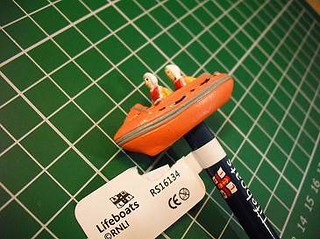 As I mentioned on Sunday, the only stand to take money off met at Hornby Magazine Live was the RNLI table. My first purchase was a rather nice pencil topped with a little D-class lifeboat.
As I mentioned on Sunday, the only stand to take money off met at Hornby Magazine Live was the RNLI table. My first purchase was a rather nice pencil topped with a little D-class lifeboat.I looked at the model and wondered what the scale was. Deciding that for the price it didn't matter, I purchased one and brought it back to my temporary workbench. I was in luck, the thing was a close to 4mm scale as made no difference. Maybe the boat was a little shrunk but the people were very close.
Pulling the top off the pencil, I tried it on the layout. It looked OK but sat rather high in the water - more on the surface than actually floating. No matter, slicing the rubbery plastic with a long knife blade (one of those snap-off versions fully extended) quickly brought it down to a more sensible level. At this point I left it on the "lake" and apart from being pushed around by a few kids, there it stayed. Well apart from the one who picked it up, clutched it to him and said "I'm just holding it" as though being protective of the little vessel.
Back at home there was one final job to do. As supplied, everything is a bit shiny but a quick squirt of Testors Dullcote quickly sorted this. I dropped the floatiness a couple of scale inches by running the model on a surform too, my original chopping hadn't resulted in a particularly flat underside but not it sites with hardly any gaps.
I don't think I'll glue the model down for the moment. I have an idea for some sort of mechanism to make it move but maybe one day.
Monday, July 16, 2012
Portholes and red oxide
 Looking at the photos of Canberra, under the waterline she is painted with the traditional red anti fouling paint. Airfix think this is topped with a black band and helpfully mould little ridges in to the hull side for both colours.
Looking at the photos of Canberra, under the waterline she is painted with the traditional red anti fouling paint. Airfix think this is topped with a black band and helpfully mould little ridges in to the hull side for both colours.Since I'm following the pictures, only the top ridge is required but they are so fine, I ignored the bottom one. The fineness makes it interesting to follow with masking tape but after a bit of fiddling, I managed a smooth line even around the pointy bits.
Colour is supposed to be brick red but plainly isn't. I mixed up a special brew from red, brick red and a Revel reddy-brown colour. The job used more than expected so a second mix was required one the original paint cup was exhausted. A bit more red in the second one produced something that looks about right. I suspect the official images are brightened up a lot, either that or the paint was bought in a job lot from the Post Office.
Above eh waterline, porthole painting has started. The round ones are easy requiring only a drop of paint into the centre of the hole. Square windows, of which there are a lot, have been represented with raised mouldings. Well, except where they are on sloping parts where the well-defined top taper to nothing at the bottom.
As previously mentioned, I'm using Railmatch Weathered Black for these and it seems to be working. I reckon a matt black would be too stark against the famous white sides.
This fiddly work is slow as after a while tension in the fingers causes cramp and less than adequate brush control. The results are worth it though, bringing the model to life as you look along the sides.
Sunday, July 15, 2012
Hornby Magazine Live 2012
This time last week I was preparing for the second day of Hornby Magazine Live in sunny(!) Hartlepool. The college venue was new, and even better than the old one, but the format was much the same - lots of layouts you've seen in the magazine with the added bonus of myself and Paul Chetter doing live demo versions of our columns.
As an added bonus for me this year, I got to drive a big van containing the crowd barriers. For a 4ft demo, I arrived in the biggest transport ever !
Anyway, all I did was sit behind my table and chat to people for two days. There was a lot of interest in the model on display, especially the Handyman Hall Railway which was especially popular since it worked. Or at least it did once I'd stripped down the loco to clean it up a bit. The Minitrains model uses an ingenious split chassis arrangement which is great unless you over-oil it at which point the electric juice stops flowing everywhere it should.
The little builders yard was as popular as ever and makes me think it's really about time I made another diorama like it. There were several other projects including a couple not yet seen in print so if you had a good look, you've enjoyed a sneak preview. Every model inspired questions from visitors and most were well handled. Hopefully a few people were inspired to go off and get their own hands dirty at the workbench.
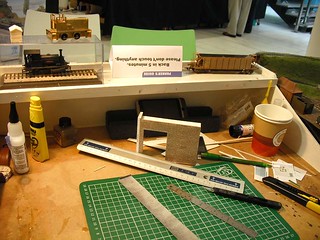 As far as making stuff went, I managed half a Scalescenes warehouse which amused the onlookers and moved another project a little closer to completion. That's not the point of the show though, it's all about the chatting. After all, I can make models at home but can't be on hand to offer advice of receive criticism unless I'm sat in the show.
As far as making stuff went, I managed half a Scalescenes warehouse which amused the onlookers and moved another project a little closer to completion. That's not the point of the show though, it's all about the chatting. After all, I can make models at home but can't be on hand to offer advice of receive criticism unless I'm sat in the show.As far as the layout went - Dunno, I didn't get out from behind the table for two days. All my photos were taken before the public arrived and often pre-switching on of the lights. Sorry about that. Trade was the same, it looked good but the only people to take money off me were the RNLI, but then you have to love the lifeboats.
Thanks very much if you dropped in to say hello. For those who were introduced to this blog by picking up a flyer, I hope you are enjoying it. If you are, tell your friends, if not, tell me !
Hornby Magazine Live photos on Flickr
Saturday, July 14, 2012
30 Shades of Grey
Full marks to Humbrol for this brilliantly funny bit of viral advertising. For those who don't get the joke, it's a play on the title of EL James book "Fifty Shades of Grey" - a novel that seems to be getting people a bit over-excited.
Some of you will know that in addition to my model-making writing, I'm dabbling in fiction and looking for a book deal - you can read all about it my other blog. Hence I am aware of the genre know as "Mommy Porn", thanks to my writing colleague banging on about it in a blog post.
I just hope the bandwagon jumping doesn't go any further. Can you image the plastic kit of scenes from the book ?
Too late, the Germans have done it already (NSFW). What sort of weirdo wants this on their train-set ? And can anyone who reads "Mommy Porn" on the train to work really claim to any less of a freak ?
Friday, July 13, 2012
Resin bits for sale
I mentioned yesterday that I had cast a load of retaining wall sections for the new Hornby Magazine N gauge MPD layout.
The moulds for these things are good for 25 castings and since we made a couple and the mag didn't need all we produced, there are some spares left. I don't want them as I have no N gauge projects in my future as far as I know.
So, they are up for grabs. Each casting measures 76mm wide by 54mm tall and is yours for the princely sum of £1 plus postage.
As an added bonus, we chucked leftover resin from each mix into moulds for 3mm scale beach huts as seen on Flockburgh and you can have these for the same price. Please note that these require the addition of a door and roof - that's how I made each one different. A few minutes work with some plasticard is all that is required to make your hut your very own special model. It's fun to do even if you don't want to go 3mil !
Interested ? Send me an e-mail and I'll let you know what is left.
Thursday, July 12, 2012
H Class conversion in Hornby Magazine
People are always moaning that you can't buy an industrial steam locomotive in OO gauge, so this month I've done my bit to fill the gap.
While not a ready to run engine, inspired by Colin Snowdon of the Double O Gauge Association, I've turned the classic L&Y Pug originally produced by Dapol and now marketed by Hornby, into a representation of a Manning Wardle H Class.
I can't claim that the result is a perfect model, but it looks pretty close and more importantly, is achievable by many modellers. You make use of the pretty good chassis and replace the body with a scratchbuilt version constructed in plastic sheet. A few castings from RT Models and a few bits from Eileens Emporium and you are there. If you have a Pug to hand it's not even a particularly expensive project.
Elsewhere, I show you how I produced the retaining wall for the Hornby Mag N Gauge layout using simple resin casting techniques.
There are also a few reviews including 3 books, a pair of fork lift trucks and yet another industrial locomotive.
Hornby Magazine Website
While not a ready to run engine, inspired by Colin Snowdon of the Double O Gauge Association, I've turned the classic L&Y Pug originally produced by Dapol and now marketed by Hornby, into a representation of a Manning Wardle H Class.
I can't claim that the result is a perfect model, but it looks pretty close and more importantly, is achievable by many modellers. You make use of the pretty good chassis and replace the body with a scratchbuilt version constructed in plastic sheet. A few castings from RT Models and a few bits from Eileens Emporium and you are there. If you have a Pug to hand it's not even a particularly expensive project.
Elsewhere, I show you how I produced the retaining wall for the Hornby Mag N Gauge layout using simple resin casting techniques.
There are also a few reviews including 3 books, a pair of fork lift trucks and yet another industrial locomotive.
Hornby Magazine Website
Wednesday, July 11, 2012
Gronk bits I like
For a future project, a couple of Hornby 08s have been sitting on my workbench. I know this RTR model train has been out for ages and I'm really late catching up, but I thought I'd mention a few bits I like anyway.
The chassis is lovely. Look at that the massive flywheel on it. Good chunky motor too. Back in the old days we'd have needed to perform some serious engineering to produce something like this or perhaps even consider a Dyna-Drive setup. This sort of mechanism was only to be found in one of our colonial cousins dirty diesels. We British modellers would moan that our 08's pancake drives weren't really suited to shunting speeds and that they really would pay more for decent motors and gears. This was before the Interweb of course, when modellers decided that moaning about the prices of RTR was more fun than buying it.
The sliding vent on the top really slides. Or comes out if you aren't careful. Now you can tell people how warm it is on your model from the position of the hatch.
The cab doors open. Why then are they fitted with a spring to close them again ? You can't run the loco with the doors open, even though I'm sure some did on a warm day. This seems like an interesting idea but I don't see the point if they can't be fixed in position.
Finally, someone has been a very smart here. Since the modern modeller takes the body on and off his or her locomotives constantly so they can tend to the evil DCC chip inside, the screw fixings are fitted with brass bushes. Not that clever you might think, but how often have you found the manufacturer relying on self-tapping screws and plastic for this sort of job ? Somewhere, there is an engineer working in the design office and he's threatened the accountant to let him do this.
Tuesday, July 10, 2012
Korean Turtle Ship in Model Boats
August's Model Boats magazine has a page on a Korean Battleship kit I built some time ago. The Turtle boat was one of the first ironclads and in model form, makes a fascinating subject.
The Academy kit is interesting in it's own right. Powered by a solar cell, drive is by oars using a very ingenious mechanism that's probably worth the price of the kit on it's own.
The moulding quality is very high and as a basis for a scale model, it's an excellent starting point. The hardest modification would be filling in the solar cell hole in the top with matching armoured plates. Possibly casting some replicas from the rest of the shell would be the easiest solution.
Anyway, much as I loved the model, regular readers will know I don't have it in my fleet any more. Read the reason why here.
Model Boats Magazine website
The Academy kit is interesting in it's own right. Powered by a solar cell, drive is by oars using a very ingenious mechanism that's probably worth the price of the kit on it's own.
The moulding quality is very high and as a basis for a scale model, it's an excellent starting point. The hardest modification would be filling in the solar cell hole in the top with matching armoured plates. Possibly casting some replicas from the rest of the shell would be the easiest solution.
Anyway, much as I loved the model, regular readers will know I don't have it in my fleet any more. Read the reason why here.
Model Boats Magazine website
Monday, July 09, 2012
Pink tractor part 2
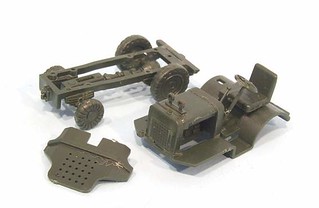 After last Monday's pink tractor photos, I was cleaning up my workbench a bit and found these bits in a "bits pot" hiding in the darkest recesses behind the turps jar. It had been very nearly under my nose for ages.
After last Monday's pink tractor photos, I was cleaning up my workbench a bit and found these bits in a "bits pot" hiding in the darkest recesses behind the turps jar. It had been very nearly under my nose for ages.In amongst some resin boat bits, there were these items I'd completely forgotten about. Sadly, I can't remember where they came from but obviously a bomb tractor or similar. In the back of my mind, some sort of American kit lurks but that's the best I can do.
Obviously once upon a time I had the idea of turning it into something and shunting tractor would certainly seem a reasonable something to turn it in to. The job should be no harder than finishing assembly and adding a couple of whacking great buffer beams suitably attached with girders.
I don't think I'll be adding a motor - but I do have some ideas in that direction once I get a ruler out so watch this space.
Sunday, July 08, 2012
Weathering tools: The cat food box
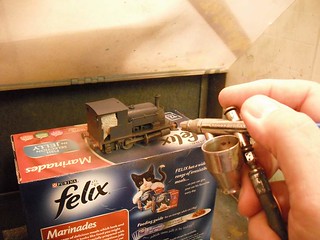 Weathering a model locomotive requires the airbrush to get in under the footplate. There are many ingenious clamping devices to facilitate this but I have a simple solution - the cat food box.
Weathering a model locomotive requires the airbrush to get in under the footplate. There are many ingenious clamping devices to facilitate this but I have a simple solution - the cat food box.My spraying is carried out in the garage next to a shelf full of pussy grub purchased in quantity when the local store is doing an offer. The boxes are strong, good enough to be used for posting things, and small enough to fit in the booth.
The extra height offered makes a difference to attacking the model. By perching it on the edge, I can get at the waggly bits easily. With the boxes being made of shiny card, the model slides around easily with a slight shove to the buffers but doesn't skid when blown by the airbrush.
Of course the paint can't get at the precious food so I don't find myself on the end of a prodding by starving puss-cats. Or at least if it does, it doesn't seem to affect their appetite !
Saturday, July 07, 2012
Dolls Domain, Leamington
Why are you showing us a shop full of jigsaws and dolls stuff ?" I hear you cry.
Simple, it's one of my local model shops, and it's recently moved so I though a quick mention would be in order.
Dolls Domain are mainly interested in supplying the surprisinly large dolls house market. if 12th scale bits and peices are your thing, and as someone who has built model boats in this scale they are for me, then you are in luck.
At the back of the shop there is a full Humbrol paints rack, loads of different modelling woods, glues, fillers and tools. They can supply anything from the Proxon range. There's a huge range of Airfix kits too.
All this from a premis in the local shopping centre, The Royal Priors. Thus, if you find yourself in Leamington on a shopping trip, the family can be abandoned in M&S and HMV while you go any buy a plastic aeroplane along with the paint and glue to assemble it. Should you be on holiday and devoid of modelling tools, they can sell you the lot for very sensible money along with a jigsaw to amuse the rest of the tribe while you are fitting the undercarriage.
Visit the Dolls Domain website
Friday, July 06, 2012
Hornby Magazine Live – Hartlepool- this weekend
Today will involve me and a van load of barriers heading up to Sunny Hartlepool for this years Hornby Live exhibition. It's a new venue so let's hope MRS Satnav can find it.
As in previous years, I'll be doing a live Paker's Guide stand where you can see past and future projects from my magazine column. It's your chance to handle the stuff you've seen picture in the magazine. If there is space in the van, at the end of the table we'll have The Handyman Hall Railway too so I have at least one thing working.
Me - hopefully I'll do nothing more than sit and chat to people. It's the best thing about shows, the chance to see if anyone reads my rubbish and has decided to have a go themselves.
See you there !
Hornby Live exhibtion on the Hornby Magazine website
As in previous years, I'll be doing a live Paker's Guide stand where you can see past and future projects from my magazine column. It's your chance to handle the stuff you've seen picture in the magazine. If there is space in the van, at the end of the table we'll have The Handyman Hall Railway too so I have at least one thing working.
Me - hopefully I'll do nothing more than sit and chat to people. It's the best thing about shows, the chance to see if anyone reads my rubbish and has decided to have a go themselves.
See you there !
Hornby Live exhibtion on the Hornby Magazine website
Thursday, July 05, 2012
Canberra Funnels
 Another "Did anyone from Airfix look at this ship before making a kit" moment arrives with the funnels. I thought I just had to stick them together, whack on the gloss buff paint and fit to the model with the little joining piece.
Another "Did anyone from Airfix look at this ship before making a kit" moment arrives with the funnels. I thought I just had to stick them together, whack on the gloss buff paint and fit to the model with the little joining piece.Then I look at my photos and spot that there is something sticking out of the top, above the swoopy tan bits.
Something black, and as far as I can tell, tubular. The pictures aren't clear thanks to the smoke coming out of the top but I think we just have a pair of round tubes. A matter of a few minutes to make with some plastic tube but still anoying.
Mind you, every time I find a picture of this boat, I spot something else wrong. The decks seemed to change colour every time it left port. Grrrrr.
Wednesday, July 04, 2012
Book Review: Life on the old railways by Tom Quinn
It's all very well knowing how many rivets there were on the left hand side of a Black Five tender, or which particular finial should be atop the signals in the Great North of Scotland in May 1905, but what about the people ?
For most modellers, people are made of plastic and hopefully the right scale. We slap a coat of paint on them and glue their feet to the model and that's it.
In real life, people were the lifeblood of the railway. Small boys would stand at the end of a platform and aspire to being the man in charge of the snorting engine at the front of the train. Railwaymen were important figures locally. A stationmaster would be of the same stature as the doctor of vicar.
All this has changed and the numbers of those who remember it are diminishing. In this book, Tom Quinn has interviewed 13 of them and gives us the edited highlights from each man's working life. The selection is varied, from engine drivers to porters. I was particularly taken with the idea that far from being a "mere" baggage carrier, porters were well respected members of staff. While not at the top of the tree, they were essential to the operation of the railway and had a far wider range of duties then you might expect.
There are lots of jobs that I've never heard of too. Do you know what a Lad Messenger was ? Me neither. Apparently he used to pick up and deliver post between platelayers huts, signal cabins and the yardmaster. At age 15.
Some interesting nicknames for locos turn up too. "Saddleback" was the slang term for LNER Y9's. I wondered as I read if this was a misprint from "saddle tank" but apparently not.
What Quinn documents is the world behind the public facade of the railway industry. This isn't a technical guide (mind you, there is an index at the back, an unexpected bonus) but a social history told through the men's own words.
As well as the text, there are a large number of very nice black and white illustrations. The only picture I don't like, is on the cover. Assuming that steam engine isn't a preserved locomotive, the child shouldn't be wearing long trousers. In those days, children simply didn't. In fact, at that age he probably ought to be in school uniform, complete with cap !
This is a minor quibble though about a very readable and enjoyable book. I went through all 217 pages in a couple of sitting, always a good sign of an easy to read book. Just the thing for taking on holiday and even suitable for someone with no interest in trains at all - my Mum loved it too !
Find out more and buy the book from the Hobby Warehouse
The full range of railway books from Hobby Warehouse
For most modellers, people are made of plastic and hopefully the right scale. We slap a coat of paint on them and glue their feet to the model and that's it.
In real life, people were the lifeblood of the railway. Small boys would stand at the end of a platform and aspire to being the man in charge of the snorting engine at the front of the train. Railwaymen were important figures locally. A stationmaster would be of the same stature as the doctor of vicar.
All this has changed and the numbers of those who remember it are diminishing. In this book, Tom Quinn has interviewed 13 of them and gives us the edited highlights from each man's working life. The selection is varied, from engine drivers to porters. I was particularly taken with the idea that far from being a "mere" baggage carrier, porters were well respected members of staff. While not at the top of the tree, they were essential to the operation of the railway and had a far wider range of duties then you might expect.
There are lots of jobs that I've never heard of too. Do you know what a Lad Messenger was ? Me neither. Apparently he used to pick up and deliver post between platelayers huts, signal cabins and the yardmaster. At age 15.
Some interesting nicknames for locos turn up too. "Saddleback" was the slang term for LNER Y9's. I wondered as I read if this was a misprint from "saddle tank" but apparently not.
What Quinn documents is the world behind the public facade of the railway industry. This isn't a technical guide (mind you, there is an index at the back, an unexpected bonus) but a social history told through the men's own words.
As well as the text, there are a large number of very nice black and white illustrations. The only picture I don't like, is on the cover. Assuming that steam engine isn't a preserved locomotive, the child shouldn't be wearing long trousers. In those days, children simply didn't. In fact, at that age he probably ought to be in school uniform, complete with cap !
This is a minor quibble though about a very readable and enjoyable book. I went through all 217 pages in a couple of sitting, always a good sign of an easy to read book. Just the thing for taking on holiday and even suitable for someone with no interest in trains at all - my Mum loved it too !
Find out more and buy the book from the Hobby Warehouse
The full range of railway books from Hobby Warehouse
Tuesday, July 03, 2012
Last days of the hovercraft
More old photos, this time of the penultimate weekend of hovercraft services accross the English Channel back in 2000.
I heard on TV that the services was to be discontinued the following weekend one Friday night. Totally out of character, I jumped on a train the next day to try and see them in operation one last time. If you've never seen a huge hovercraft moving then you won't understand just how increadible they are.
First, there is the noise. These things are as loud as an aeroplane - hardly surprising with those 4 massive propellers in action. Then there is the size. At rest the SRN4 is big. Turn the fans on to inflate the skirts and it rises up by another 15 feet or more.
Finally, there is the spray. All that air blasts the water underneath around so that the sight as it comes in to the harbour is a cloud of spray with the big beast in the centre. Something about it racing towards the shore and not stopping when it gets there seems unatural too, even though it's exactly what they are built for.
On my trip I'd also taken my passport on the off-chance of a ride. During the train journey, I rang the ticket office and was amazed to be able to book a day return. An upgrade to 1st class was even available, something I took up for the return from France.
The ride was a little bumpy and very noisy. The interior was tatty but then it was nearly the end of the line for the Princess Anne. Her customers were just the sort you'd expect when the only thing that makes the service pay is duty-free sales. I racall a lady pulling a shopping trolley arguing with the steward most of the way over the amount of fags she could buy. They went through many perumutations of brands and quantitites before she worked out the maximum number for the cash she was spending. Looking at her, she probably did the trip once a month and smoked them all in between.
Like her, I didn't bother leave the hoverport in France. It was in the arse end of nowehere. It didn't matter, I was able to watch the other member of the fleet arrive and epart as well as some one-man craft batting around the apron. Anyway, I was allowed into the 1st class lounge with all the Dansih pastries I could eat and free coffee to wash them down. What more could France offer ?
Now, another transport of the future is in a museum. One day, I hope to visit and have another look. For the moment, take a look at the view from the air. I told you they were big didn't I ?
View Larger Map
Modelling options are limited for these beasts. The obvious choice would be the Airfix SRN4 plastic kit, but sadly this isn't currently available. I'd love to have a go if anyone has one languishing in a drawer they want no money for.
Alternativly, the more advanced modeller, how about a scratch build ? There is a lovely model here but beware, you need to keep the weight down if the thing is to "fly" so it won't be easy to copy !
Monday, July 02, 2012
Little pink tractor
Digging through some old photos, I found this little beauty. I can't work out where it was taken, or when, although the back of the print mentions Kodak being a sponsor of the Olympics at the time.
I suspect that this tractor is an airport vehicle used for hauling around baggage carts and other trolleys. It's possibly even an aircraft mover although not for jumbo jets. The mudguards certainly didn't originate from a farm and it's a bit of a low-rider for furrowed fields.
Vehicles simialr to this appeared as railway shunters and wouldn't be too difficult to convert from a model tractor. Check out this one from Paul Bartletts photo site. The faded paintwork would be much more of a challenge. I suspect a nice dusty red base coat followed by some heavy dry-brush work with the white paint would be a good start. Other suggestions are very welcome though.
Update: Now identified as an old David Brown, airfield "Tug". That's David Brown the tractor maker not top DJ.
Update: Now identified as an old David Brown, airfield "Tug". That's David Brown the tractor maker not top DJ.
Sunday, July 01, 2012
DOGA AGM modelling competition 2012
Last weekend saw the 2012 Double O Gauge Association AGM in London. As usual, I was in charge of the modelling competition. Full results will appear elsewhere in due course but I thought I'd sneak you a few pics of some of the entries:
The SECR C Class was built by Alan Harding from a Falcon Brass kit. Considering that these aren't the easiest of kits to build, it's a very nice looking model.
Another model by Alan Harding, this time a Bullied Tavern car based on a Bachmann RTR coache with Comet sides and much added detail.
Finally, a Concertina Brake 3rd scratchbuilt by Colin Snowdon. His original plan involved doing the 3rd class coach, but after the effort required for this one, he decided against that !
Hopefully, pictures of all the entries will appear in due course on www.doubleogauge.com/
The SECR C Class was built by Alan Harding from a Falcon Brass kit. Considering that these aren't the easiest of kits to build, it's a very nice looking model.
Another model by Alan Harding, this time a Bullied Tavern car based on a Bachmann RTR coache with Comet sides and much added detail.
Finally, a Concertina Brake 3rd scratchbuilt by Colin Snowdon. His original plan involved doing the 3rd class coach, but after the effort required for this one, he decided against that !
Hopefully, pictures of all the entries will appear in due course on www.doubleogauge.com/
Subscribe to:
Comments (Atom)

